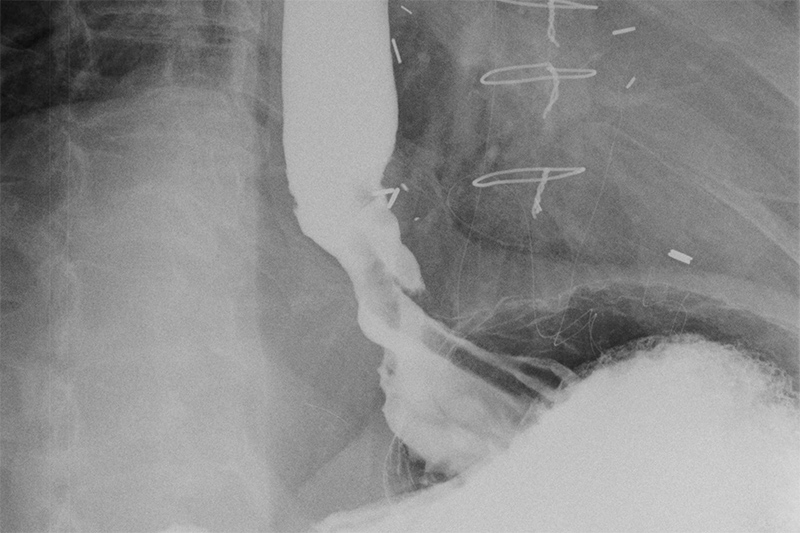The esophagus as the entry way to the digestive system
From the back of the mouth (the pharynx) to the top of the stomach, the esophagus is a muscular tube for foods and liquids. It’s relatively tough and resilient as organs go, built to take most of the material human beings ingest. For the most part, it’s not a very complicated organ. Depending on the height of the person, it’s about 10 inches long (25 cm) and 1 inch in diameter (2-3 cm). The esophagus’ geography usually divides into three sections: cervical at the top, thoracic in the middle, and abdominal at the bottom.
The Esophagus can become Irritated

At the top of the esophagus
At the top, the esophagus has a gate, or more anatomically expressed – a sphincter – a set of muscles known as the inferior pharyngeal sphincter. Working in synchronization with the tongue and muscles in the back of the pharynx, this sphincter opens to allow food, air and liquid into the esophagus, and then closes to prevent unwanted aspiration. Of course, this is simply part of what we call ‘swallowing.’
Once past this gate, food and liquid starts down the esophagus, the area we identify as the throat. Food usually goes down with the help of gravity but rhythmic contractions by the muscles lining the wall of the esophagus do most of the work. This movement, known as peristalsis, pushes material downward much as the intestines move material from the stomach to the anus.
Also near the top of the esophagus is a junction with the windpipe, guarded by the epiglottis, a flap of muscle and tissue that opens and closes to allow air into the larynx and trachea. It’s easy to understand that the timing of muscle movement – pharyngeal sphincter, epiglottis, muscles of the esophagus – is important. Everybody has had experience with ‘swallowing wrong’ (sending food down the windpipe), sore throats, difficulty swallowing and perhaps choking on a piece of food.
In the middle of the esophagus
Once past the epiglottis, the esophagus is mostly a straight drop toward the stomach. In this thoracic area, from the surgical point of view there are just two points of interest. One is the area where the esophagus crosses the area near the heart, specifically the aortic arch. The other is at the hole where the esophagus crosses the diaphragm, the membrane that separates the thoracic region from the abdominal. These crossing points may complicate surgery.
Esophageal Manometry studies muscle contraction

At the bottom of the esophagus
Achalasia affects the lower esophageal opening

Where the esophagus enters the stomach, is another sphincter, the gastroesophageal junction. Here the sphincter opens to allow food into the stomach and closes to prevent stomach fluids (bile, gastric acids) from entering the esophagus. Unfortunately, this is one of the weak points of the digestive system. Old age, overeating, obesity and a number of diseases may cause the gastroesophageal junction to function poorly, allowing stomach fluids into the esophagus. When this happens occasionally, we call the burning sensation ‘heartburn’ or acid reflux and perhaps take an antacid. When this happens often (a chronic condition), it becomes gastroesophageal reflux disease, or GERD.
Diseases of the esophagus
A common disease of the esophagus, at least in the developed world, starts with GERD. If untreated, the constant washing by stomach acid damages the tissue of the esophagus lining. As the damage progresses, a condition known as Barrett’s esophagus takes over and the esophagus cells begin to mutate into stomach cells. Although the exact biochemistry is unknown, this process makes the lower (abdominal) area of the esophagus prone to adenocarcinoma, a form of cancer becoming rapidly more prevalent.
Esophageal Cancer at the GastroEsophageal Junction
 This image of a barium swallow demonstrates a length of about 4 to 5 cm in the distal esophagus characterized by a nodular irregular mucosa with overhanging edges, probable ulceration and significant obstruction to the passage of the barium tablet. Findings such as these are typically worrisome for a neoplastic process and usually require further evaluation with endoscopy and tissue biopsy.
This image of a barium swallow demonstrates a length of about 4 to 5 cm in the distal esophagus characterized by a nodular irregular mucosa with overhanging edges, probable ulceration and significant obstruction to the passage of the barium tablet. Findings such as these are typically worrisome for a neoplastic process and usually require further evaluation with endoscopy and tissue biopsy.Not surprisingly, diseases of the esophagus often relate to what we eat, drink and breathe. Smoking tobacco, in particular, has many nasty effects including cancer (usually squamous cell). Drinking strong alcohol is likewise destructive of esophagus tissue and may lead to esophageal cancer
Physicians may treat cancer of the esophagus with chemotherapy, radiology and surgery. The surgical option is usually removal of all or part of the esophagus, an esophagectomy, along with the tumor(s) and any other tissue such as lymph nodes affected by cancer. An esophagectomy for cancer, especially in the abdominal portion of the esophagus is a very difficult and complex operation. Minimally invasive surgical techniques (for example, a thoracolaparoscopic esophagectomy) help reduce the trauma and recovery time.


